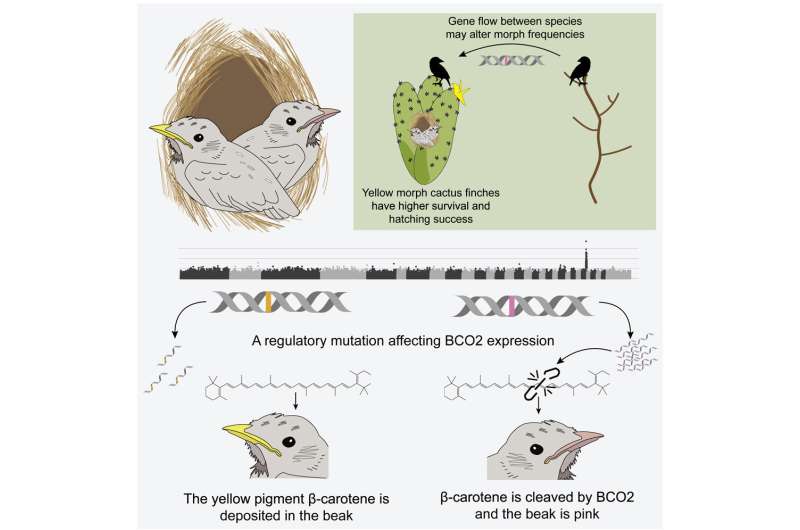Why some of Darwin's finch nestlings have yellow beaks

Carotenoids are the underlying pigment for much of the enormous variety of color found across birds and form the basis for the colors red, yellow and orange. In a study published in Current Biology, researchers from Uppsala University and Princeton University have uncovered the genetic basis for the yellow beak of some Darwin's finch nestlings.
Birds are not able to produce carotenoids themselves and obtain them by eating foods that contain carotenoids, such as insects and plants. In fact, much of the variation in beak, leg and feather colors that can be observed among bird species are due to carotenoids. However, the genetic basis for this variation is poorly understood because it is not possible to infer which of the millions of genetic differences between species are controlling the difference in carotenoid pigmentation. However, when variation occurs within species researchers can use modern genetic tools to identify the variation in DNA sequence underlying the visible phenotype.
The Darwin's finches on Galápagos provide such an opportunity because the beak color of nestlings in several species are either yellow (with carotenoids) or pink (lacking carotenoids). An unusual feature of the Darwin's finch beak color is that it is only visible before birds leave the nest. As adults, the beaks of most Darwin's finches are entirely black due to deposition of melanin.
"We sequenced the entire genome of hundreds of birds with yellow and pink beaks and found that the only consistent difference between these groups was a single base change in the gene BCO2 coding for the enzyme beta-carotene oxygenase 2 that degrades carotenoids," says Erik Enbody who performed this analysis as a post-doctoral fellow at Uppsala University.
"It's a really interesting gene that degrades a certain type of carotenoid and the finches that have the genetic mutation we identify express this gene at a lower amount, leading to the yellow carotenoid pigment being deposited in the beak," says Enbody.
"We first discovered the importance of BCO2 for controlling carotenoid pigmentation in vertebrates when we showed that domestic chickens with yellow legs do not express this enzyme in skin due to a regulatory mutation in BCO2. Since then, it has become apparent that BCO2 is a master regulator for carotenoid pigmentation in vertebrates as illustrated in the present study," says Leif Andersson at Uppsala University and Texas A&M University.
The mutation is present across species of Darwin's finches on the Galápagos Islands, which allowed the researchers to identify the origin of the mutation approximately 500,000 years ago. This means that the mutation controlling beak color predates the origin of many of present-day Darwin's finch species. The researcher used the mutation to track the beak color variation in some species of Darwin's finches across forty years on a small island in the Galápagos, using the samples collected by Peter and Rosemary Grant at Princeton University.
"We found that the beak color of the cactus specialist finch, the Common Cactus Finch, varies with the availability of cacti on the island," explains Peter and Rosemary Grant. "As carotenoids are present in the pollen and nectar of Opuntia cactus flowers, which the cactus finches consume, they may influence how common the yellow beak color is in nestlings. One advantage we identified is a higher hatching success for those carrying the yellow mutation, which may be possible if the yellow beak finches deposit more carotenoids in their eggs. Carotenoids are the basis for the yellow color of egg yolk," say Peter and Rosemary Grant.
"Carotenoid pigments are ubiquitous in the feathers and skin of the enormous variety of color observable across bird species. Variation within species may provide clues for how differences between species evolve, and these findings in Darwin's finches suggest that the selective advantage of presence/absence of carotenoid pigmentation may be related to diet," says Erik Enbody.
More information: Erik D. Enbody et al, A multispecies BCO2 beak color polymorphism in the Darwin's finch radiation, Current Biology (2021). DOI: 10.1016/j.cub.2021.09.085
Journal information: Current Biology
Provided by Uppsala University


















